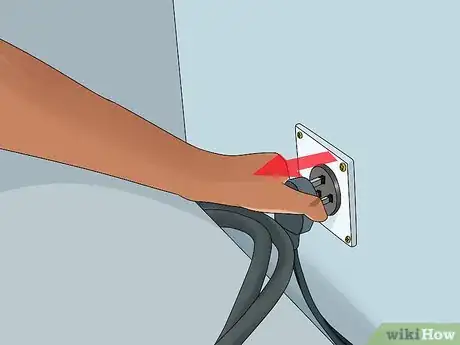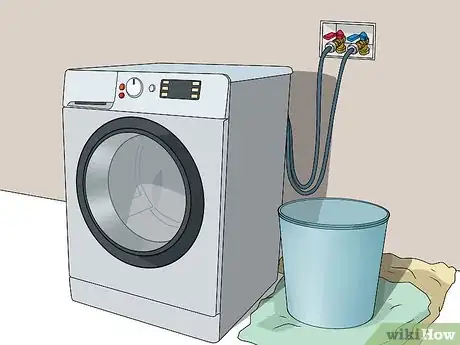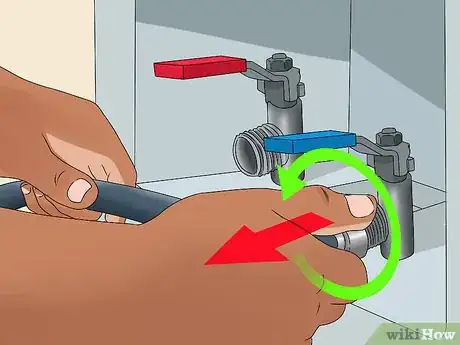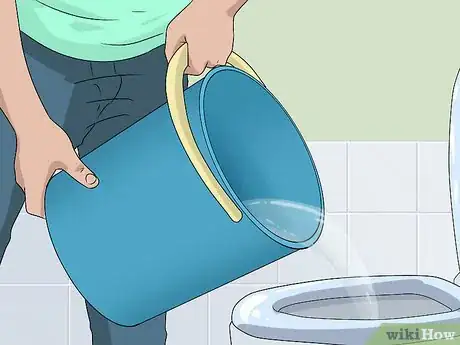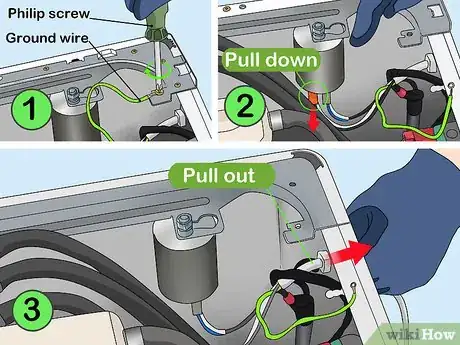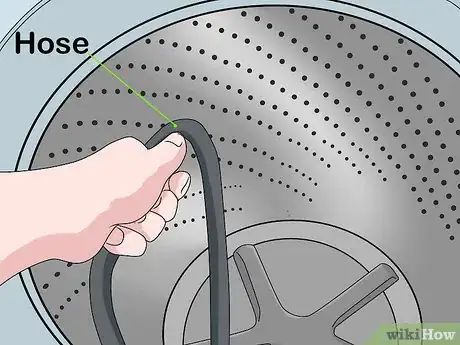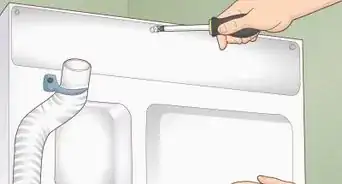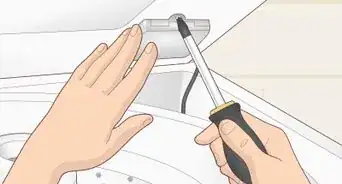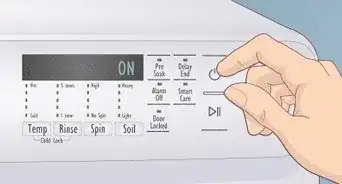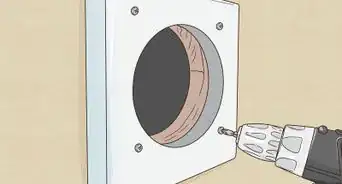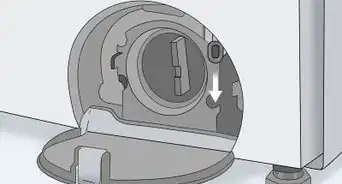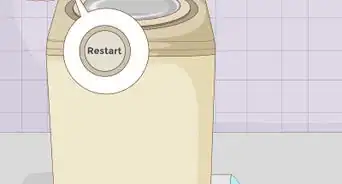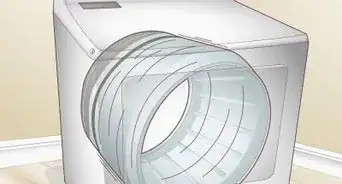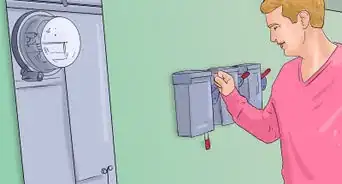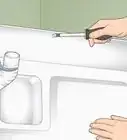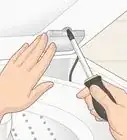This article was co-authored by Mark Spelman. Mark Spelman is a General Contractor based in Austin, Texas. With over 30 years of construction experience, Mark specializes in constructing interiors, project management, and project estimation. He has been a construction professional since 1987.
There are 9 references cited in this article, which can be found at the bottom of the page.
wikiHow marks an article as reader-approved once it receives enough positive feedback. This article received 13 testimonials and 88% of readers who voted found it helpful, earning it our reader-approved status.
This article has been viewed 916,932 times.
A washing machine is not an appliance that is often moved around the house. The machine is usually found in the basement, in a dedicated laundry room, or in the garage, and that is where it stays for most of its life. There are times when the washing machine will need to be moved, however. When the machine is being replaced, or moved to a new home, it will need to be disconnected from the hoses and wires that supply it with power and water. These instructions will guide you through the both the process of disconnecting your machine and getting it ready to move out of its usual location.
Steps
Disconnecting Your Machine
-
1Turn off the water valves. Valves for the supply of hot and cold water are usually located behind the washing machine and in a washer box attached to the wall. Turn off the valves by turning them clockwise until they cannot be turned any further.
- You'll want to turn these off first thing.[1] This will protect you from major spills if you should accidentally tear a hose in step 2.
-
2Pull or drag the washing machine away from the wall. If working alone, grab one side and move it forward, then do the same with the other side. If you have help, try pulling on opposite sides simultaneously.
- Pull the machine as far out as you can without putting stress on the hoses. Ideally, this will be far enough away from the wall that you can step behind the machine.[2]
- If your house is on the newer side, some new water boxes are above the washer so it's easier to reach the lines without moving the machine.
Advertisement -
3Unplug the washing machine. Make sure the washing machine is not running, and pull the plug out of the outlet. This will disconnect the washing machine from its power supply.[3]
-
4Get a bucket. Place a water pan or bucket behind the washing machine, under the water lines where it will catch water. Surround the bucket with several towels to catch any additional leaks or water that may spill out when the pipes are detached.
-
5Detach the hoses from the machine. If they are attached with clamps, turn the screws atop the clamps counterclockwise until the clamps are loose. Then, point the ends of the hoses toward your bucket to drain any water. Alternatively, you can place them in the drain, located in the washer box.
- It's a good idea to double-check that your valves are still off before doing this. Some styles of faucet handles are easy to accidentally turn back on, and this could have occurred as you moved the machine or when you stepped behind it.[4]
- You may find it helpful to wait a few seconds after turning off the valves to try to remove the hoses, as this will allow the pressure in the hoses to abate, making them easier to remove.[5]
- Turning on a few other faucets in the house may help them drain more quickly.
-
6Remove the hoses from the wall.Turn the ends counterclockwise until the hoses detach.
- You may need to use adjustable pliers or a pipe wrench to loosen the hoses, especially if the machine hasn't been disconnected in a while.[6]
- Once you've removed them, drain any remaining water into the bucket.
-
7Remove the drain hose from the drain. Depending on your plumbing setup, this might be a laundry sink, a floor drain, a wall-mounted drain, or a tall stand-pipe. Each of these requires a slightly different process of hose removal. Consult the instructions that came with your machine if it is not immediately obvious.
- Point the free end of this hose toward your bucket as well, to allow any water to flow out.
Preparing the Machine to Be Moved
-
1Empty the water bucket. Before moving the machine, get the water bucket out of the way. Wipe up any spills or drips. You wouldn't want to slip while moving the machine.
-
2Double check your connections. Ensure there are no additional plugs or hoses connecting the washing machine to the wall. Continue moving the machine out of its place. There may be water inside the washing machine.
-
3Clean the intakes. If you are keeping this washer, this is a good opportunity to clean the water intakes with a bristle brush to remove any debris that may have accumulated over the years.[7]
-
4Remove the power cord. Unless you are setting the machine back up in the same spot, it's a good idea to remove the power cord or, if it is not removable, tape it in place.[8]
- This will protect the plug and prevent the cord from being pulled out accidentally during moving.
- It's also a good idea to remove any knobs that can come off the machine, to prevent loss.[9]
-
5Secure the drum. If you will be moving the washing machine any significant distance, it is important to secure the "drum," the inner chamber of the washer that moves.[10]
- Depending on the model of your machine, this can be achieved with special bolts, a large y-shaped piece of foam, or even simply tightening some screws in the back.[11]
- Consult your manual on how best to secure the drum in your machine. You may need to buy a special kit for this.
-
6Wrap up your parts. If you are planning to move the machine any distance, leave your cords attached to the machine. You can tape any dangling cords to the sides of the washer to keep them out of your way.
Expert Q&A
-
QuestionWhen disconnecting a washing machine, do I need to turn the water off at the mains?
 Mark SpelmanMark Spelman is a General Contractor based in Austin, Texas. With over 30 years of construction experience, Mark specializes in constructing interiors, project management, and project estimation. He has been a construction professional since 1987.
Mark SpelmanMark Spelman is a General Contractor based in Austin, Texas. With over 30 years of construction experience, Mark specializes in constructing interiors, project management, and project estimation. He has been a construction professional since 1987.
Construction Professional There should be water supply valves located behind the machine. No need to turn of at the mains, just turn it off there.
There should be water supply valves located behind the machine. No need to turn of at the mains, just turn it off there. -
QuestionI disconnected my washing machine, and l still have water coming from one of the hoses. What do I do?
 Mark SpelmanMark Spelman is a General Contractor based in Austin, Texas. With over 30 years of construction experience, Mark specializes in constructing interiors, project management, and project estimation. He has been a construction professional since 1987.
Mark SpelmanMark Spelman is a General Contractor based in Austin, Texas. With over 30 years of construction experience, Mark specializes in constructing interiors, project management, and project estimation. He has been a construction professional since 1987.
Construction Professional There might be residual water in the line or the valve may be broken.
There might be residual water in the line or the valve may be broken. -
QuestionMy water-valve knob is broken, so I have to turn the water off to the house when moving my washer. We recently sold our home. When we move our washer out, can we just cap the waterline? Or will the pressure not hold the cap?
 Mark SpelmanMark Spelman is a General Contractor based in Austin, Texas. With over 30 years of construction experience, Mark specializes in constructing interiors, project management, and project estimation. He has been a construction professional since 1987.
Mark SpelmanMark Spelman is a General Contractor based in Austin, Texas. With over 30 years of construction experience, Mark specializes in constructing interiors, project management, and project estimation. He has been a construction professional since 1987.
Construction Professional You will need to repair the valve before moving.
You will need to repair the valve before moving.
Warnings
- Washing machines are very heavy. If you aren't certain that you are strong enough to move one on your own, get help! It may prevent a back injury. An appliance dolly is best, if there's room.⧼thumbs_response⧽
References
- ↑ http://www.london-plumber.co.uk/how-to-disconnect-reconnect-a-washing-machine
- ↑ http://www.thisoldhouse.com/toh/asktoh/question/0,,1585845,00.html
- ↑ http://www.emovingstorage.com/disconnect-and-reconnect-washing-machines/
- ↑ http://www.london-plumber.co.uk/how-to-disconnect-reconnect-a-washing-machine/
- ↑ http://www.thisoldhouse.com/toh/asktoh/question/0,,1585845,00.html
- ↑ http://www.thisoldhouse.com/toh/how-to/step/0,,20052014,00.html
- ↑ http://www.thisoldhouse.com/toh/how-to/step/0,,20052014_683986,00.html
- ↑ http://www.emovingstorage.com/disconnect-and-reconnect-washing-machines/
- ↑ http://www.emovingstorage.com/disconnect-and-reconnect-washing-machines/
- ↑ http://www.emovingstorage.com/disconnect-and-reconnect-washing-machines/
- ↑ http://www.wheatonworldwide.com/planning-guides/how-to-move-your-appliances/
- ↑ http://www.moving.com/tips/must-know-tips-for-moving-with-major-appliances/
- ↑ http://www.thisoldhouse.com/toh/asktoh/question/0,,1585845,00.html
- Videos provided by Bellhops
About This Article
To disconnect a washing machine, turn off the water valves located behind the washing machine by turning them clockwise. Next, pull the machine away from the wall and unplug it. Place a bucket behind the machine to catch water drainage, then turn the ends of the hoses counterclockwise to detach them from the wall. You may need pliers to loosen them! Then, remove the drain hose to complete the disconnection. For tips on moving a disconnected washing machine, read on!


